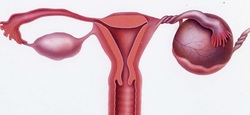
ovarian torsion is when the ovary twists on itself, depriving itself of blood supply, in effect strangling itself. if the blood supply is compromised completely then there is the risk that the ovary “kills” itself and ceases to function.
the female ovary is responsible for the production of female hormones, and the production of eggs for fertility.
it is an organ located in the pelvis and is connected to the uterus (womb) by means of a pedicle. it is this pedicle that twists during this gynaecological emergency.
Torsion of the ovary and or fallopian tube is responsible for between 3-8% of all gynaecological emergencies
women present with sudden onset acute lower abdominal pain, sometimes central or on either side of the lower abdomen depending on which ovary is involved, right or left.
The pain can be constant or intermittent (as the ovary can twist and untwist). The pain may radiate to the back or down the leg on the affected side. Most women also have nausea and vomiting with loss of appetite.
In order that the ovary does not become compromised prompt diagnosis is essential, as delay in diagnosis can result in loss of the affected ovary and potentially reduced reproductive capacity.
Unfortunately ovarian torsion remains a diagnostic challenge for carers who look after women who present with abdominal pain in the emergency setting. A lot relies on a high index of suspicion and taking a good history and examination.
It is strongly associated with ovarian cysts of around 5cm or more and these cysts tend to be dermoids.
It can however occur in the absence of ovarian cysts particularly in pre-pubertal girls and post-menopausal women.
There are certain ultrasound features that are associated with ovarian torsion, but the absence of these features does not fully rule out the possibility that torsion has occurred.
The treatment of this condition is always surgical and nowadays should always be by means of laparoscopic surgery, with the aim of conserving the ovary rather than taking it out, as even though the ovary may look “dead” it may still be viable.
The ovary should be untwisted, if a cyst is present it is removed and the ovary left behind.
No one knows what the risk of recurrence of torsion of ovarian cyst is. For this reason some surgeons advocate fixing the ovary or the other ovary to the back of the womb or shortening the ligament that attaches the ovary to the womb.
Once the condition is treated it usually takes a few weeks for the body to return to normal. some centres arrange ultrasound scans at about 4 weeks after treatment to assess the condition of the ovary left behind








 RSS Feed
RSS Feed